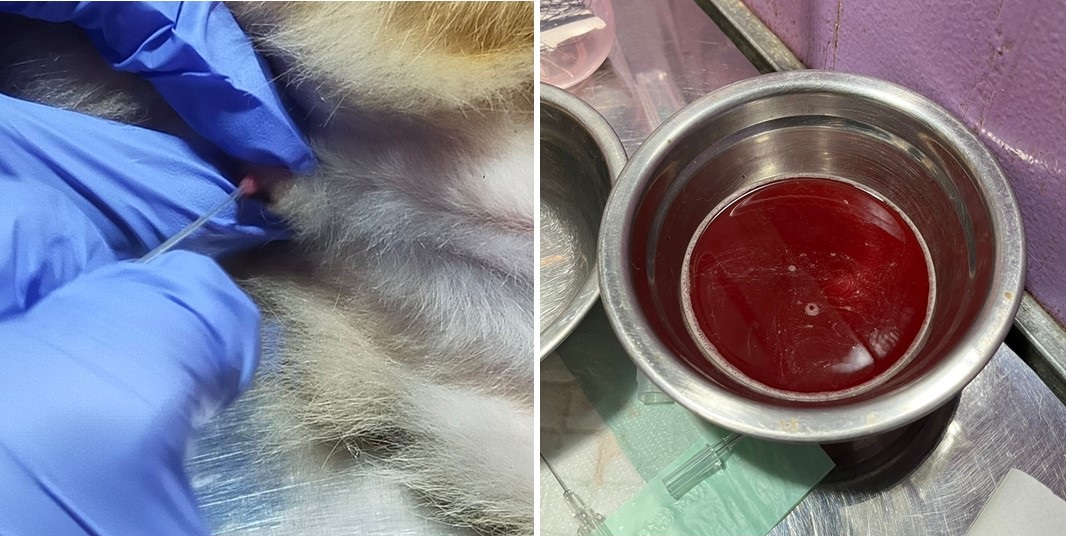Use of an intravenous catheter to treat urinary distension in cases of feline lower urinary tract disease
Abstract
Urolithiasis is a disease that commonly affects the urinary organs due to blockage of crystal stones in the urinary tract of male cats. A 3.5 year old male mixed breed domestic cat was examined at the Royal Purple Vet Clinic with complaints of a lack of appetite, fever, and vomiting. The results of the physical examination showed that the body temperature was 39.6°C, bladder distention occurred, and there was a pain response when palpated. Under emergency conditions, urinary distension was treated by insertion of an intravenous catheter (26G). Supporting examinations included urinalysis and microscopic examination of urine. Urinalysis results showed the presence of red blood cells, white blood cells, and protein in the urine. Meanwhile, the results of the microscopic examination showed that there were deposits of calcium oxalate crystal particles. The cat was diagnosed with urolithiasis with a Fausta prognosis. The treatment includes fluid therapy, antibiotics, anti-inflammatories, supplements, and herbal medicine. The cat experienced changes after being treated for four days, characterized by normal urination and no blood found in the urine
Downloads
References
Callens A, Bartges JW. 2016. Update on Feline Urolithiasis. August's Consultations in Feline Internal Medicine. 7:499-508. https://doi.org/10.1016/B978-0-323-22652-3.00051-7
Davidow EB. 2020. Retrospective evaluation of urinary indwelling catheter type in cats with urethral obstruction (January 2014 to December 2014): 91 cases. Journal of Veterinary Emergency and Critical Care. 30(2): 239-242. https://doi.org/10.1111/vec.12945 | PMid:32090406
Davis H, Jensen T, Johnson A, Knowles P, Meyer R, Rucinsky R, Shafford H. 2013. 2013 AAHA/AAFP fluid therapy guidelines for dogs and cats. Journal of the American Animal Hospital As-sociation. 49(3): 149-59. https://doi.org/10.5326/JAAHA-MS-5868 | PMid:23645543
Fielder S, Theresa R. 2010. Urine Crystals in Cats and Dogs. NAVC Clinician's Brief.
Lund HS, Eggertsdóttir AV. 2019. Recurrent episodes of feline lower urinary tract disease with different causes: possible clinical implications. Journal of Feline Medicine and Surgery. 21(6): 590-594. https://doi.org/10.1177/1098612X18783839 | PMid:29943625
Nururrozi A, Yanuartono Y, Sivananthan P, Indarjulianto S. 2020. Evaluation of lower urinary tract disease in the Yogyakarta cat population, Indonesia. Veterinary world. 13(6): 1182-1186. https://doi.org/10.14202/vetworld.2020.1182-1186 | PMid:32801571 PMCid:PMC7396331
Olin SJ, Bartges JW. 2015. Urinary Tract Infections. Veterinary Clinics of North America: Small Animal Practice. 45(4): 721-746. https://doi.org/10.1016/j.cvsm.2015.02.005 | PMid:25824394 PMCid:PMC7114653
Panchaphanpong J, Asawakarn T, Pusoonthornthum R. 2011. Effects of oral administration of N-acetyl-d-glucosamine on plasma and urine concentrations of glycosaminoglycans in cats with idiopathic cystitis. American Journal of Veterinary Re-search. 72(6): 843-850. https://doi.org/10.2460/ajvr.72.6.843 | PMid:21627533
Plumb DC. 2011. Plumb's Veterinary Drug Handbook, 7th ed. Pharmavet Inc.
Tilley LP, Francis WK, Smith Jr, Meg MS, Benjamin MB. 2021. Blackwell's Five-Minute Veterinary Consult: Canine and Feline. 7th ed. Hoboken, New Jersey, US: Wiley Blackwell.
Yadav SN, Ahmed N, Nath AJ, Mahanta D, Kalita MK. 2020. Urinalysis in dog and cat: A review. Veterinary world. 13(10): 2133-2141. https://doi.org/10.14202/vetworld.2020.2133-2141 | PMid:33281347 PMCid:PMC7704312
Zhong YS, Yu CH, Ying HZ, Wang ZY, Cai HF. 2012. Prophylactic effects of Orthosiphon stamineus Benth. extracts on experimental induction of calcium oxalate nephrolithiasis in rats. Journal of ethnopharmacology. 144(3): 761-767. https://doi.org/10.1016/j.jep.2012.09.052 | PMid:23123267

Copyright (c) 2023 CC-BY-SA

This work is licensed under a Creative Commons Attribution-ShareAlike 4.0 International License.
Authors who publish with this journal agree to the following terms:
1. Authors retain copyright and grant the journal right of first publication with the work simultaneously licensed under a Creative Commons Attribution License that allows others to share the work with an acknowledgement of the work's authorship and initial publication in this journal.
2. Authors are able to enter into separate, additional contractual arrangements for the non-exclusive distribution of the journal's published version of the work (e.g., post it to an institutional repository or publish it in a book), with an acknowledgement of its initial publication in this journal.
3. Authors are permitted and encouraged to post their work online (e.g., in institutional repositories or on their website) prior to and during the submission process, as it can lead to productive exchanges, as well as earlier and greater citation of published work (See The Effect of Open Access).

.jpg)















